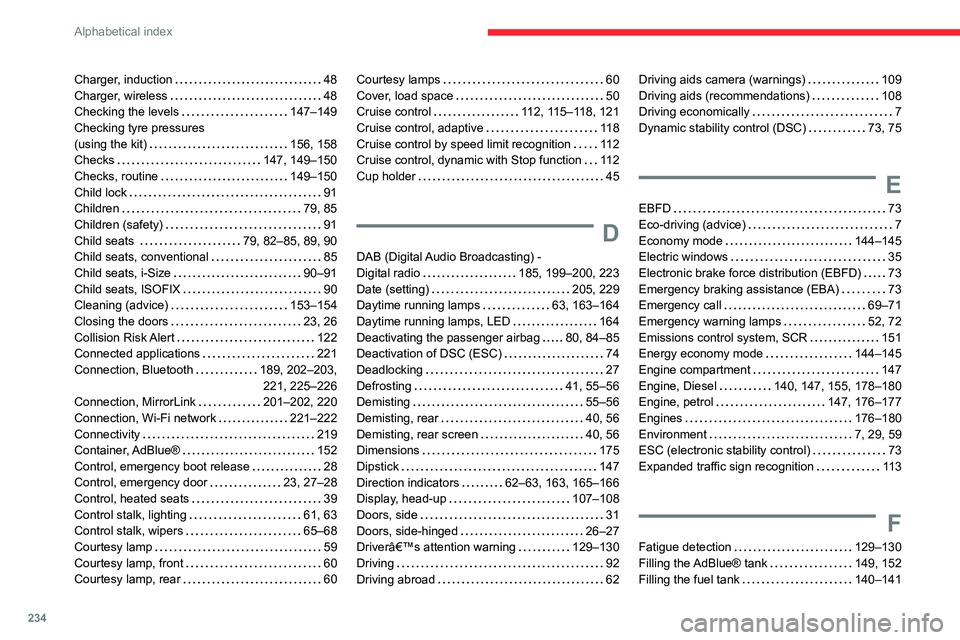fuel fill door release CITROEN BERLINGO VAN 2021 Handbook (in English)
[x] Cancel search | Manufacturer: CITROEN, Model Year: 2021, Model line: BERLINGO VAN, Model: CITROEN BERLINGO VAN 2021Pages: 260, PDF Size: 7.57 MB
Page 154 of 260

152
Practical information
You can also visit a service station equipped with AdBlue® pumps specially
designed for private vehicles.
Never top up from an AdBlue® dispenser
reserved for heavy goods vehicles.
Storage recommendations
AdBlue® freezes at about -11°C and deteriorates
above +25°C. Containers should be stored in a
cool area and protected from direct sunlight.
Under these conditions, the fluid can be kept for
at least a year.
If the fluid has frozen, it can be used once it has
completely thawed out in the ambient air.
Never store AdBlue® containers in your
vehicle.
Precautions for use
AdBlue® is a urea-based solution. This fluid is
non-flammable, colourless and odourless (when
kept in a cool place).
In the event of contact with the skin, wash the
affected area with soap and running water. In the
event of contact with the eyes, immediately rinse
the eyes with large amounts of water or with an
eye wash solution for at least 15 minutes. Seek
medical attention if you feel a persistent burning
sensation or irritation.
If swallowed, immediately wash out the mouth
with clean water and then drink plenty of water.
In certain conditions (high temperature, for
example), the risk of release of ammonia cannot
be excluded: do not inhale the fluid. Ammonia
vapours have an irritant effect on mucous
membranes (eyes, nose and throat).
Store AdBlue® out of the reach of
children, in its original container.
Procedure
Before starting the top-up procedure, ensure that
the vehicle is parked on a flat and level surface.
In wintry conditions, ensure that the temperature
of the vehicle is above -11
°C. Otherwise the
AdBlue
® may be frozen and so cannot be poured
into its tank. Park the vehicle in a warmer area
for a few hours to allow the top-up to be carried
out.
Never put the AdBlue® into the Diesel
fuel tank.
If any AdBlue® is splashed, or if there are
any spillages on the bodywork, rinse
immediately with cold water or wipe with a
damp cloth.
If the fluid has crystallised, clean it off using a
sponge and hot water.
Important: in the event of a top-up after
a breakdown because of a lack of
AdBlue, it is essential to wait around 5
minutes before switching on the ignition,
without opening the driver’s door,
unlocking the vehicle, introducing the key
into the ignition switch, or introducing the
key of the “Keyless Entry and Starting
”
system into the passenger compartment
.
Switch on the ignition, then wait for 10
seconds before starting the engine.
►
Switch off the ignition and remove the key
from the switch to switch off the engine.
or
►
With Keyless Entry and Starting, press the
"
START/STOP" button to switch off the engine.
► With the vehicle unlocked and the fuel filler
flap open, turn the blue cap of the AdBlue® tank
anti-clockwise and remove it.
►
With a container of
AdBlue
®: after checking
the expiry date, read carefully the instructions
on the label before pouring the contents of the
container
into the vehicle's AdBlue tank.
►
With an
AdBlue® pump: introduce the nozzle
and fill the tank until the automatic cut-off of the
nozzle.
In order not to overfill the AdBlue® tank:
–
Add between 10 and 13 litres using
AdBlue® containers.
Page 236 of 260

234
Alphabetical index
Charger, induction 48
Charger, wireless
48
Checking the levels
147–149
Checking tyre pressures
(using the kit)
156, 158
Checks
147, 149–150
Checks, routine
149–150
Child lock
91
Children
79, 85
Children (safety)
91
Child seats
79, 82–85, 89, 90
Child seats, conventional
85
Child seats, i-Size
90–91
Child seats, ISOFIX
90
Cleaning (advice)
153–154
Closing the doors
23, 26
Collision Risk Alert
122
Connected applications
221
Connection, Bluetooth
189, 202–203,
221, 225–226
Connection, MirrorLink
201–202, 220
Connection, Wi-Fi network
221–222
Connectivity
219
Container, AdBlue®
152
Control, emergency boot release
28
Control, emergency door
23, 27–28
Control, heated seats
39
Control stalk, lighting
61, 63
Control stalk, wipers
65–68
Courtesy lamp
59
Courtesy lamp, front
60
Courtesy lamp, rear
60Courtesy lamps 60
Cover, load space
50
Cruise control
112, 115–118, 121
Cruise control, adaptive
11 8
Cruise control by speed limit recognition
11 2
Cruise control, dynamic with Stop function
11 2
Cup holder
45
D
DAB (Digital Audio Broadcasting) -
Digital radio
185, 199–200, 223
Date (setting)
205, 229
Daytime running lamps
63, 163–164
Daytime running lamps, LED
164
Deactivating the passenger airbag
80, 84–85
Deactivation of DSC (ESC)
74
Deadlocking
27
Defrosting
41, 55–56
Demisting
55–56
Demisting, rear
40, 56
Demisting, rear screen
40, 56
Dimensions
175
Dipstick
147
Direction indicators
62–63, 163, 165–166
Display, head-up
107–108
Doors, side
31
Doors, side-hinged
26–27
Driver’s attention warning
129–130
Driving
92
Driving abroad
62
Driving aids camera (warnings) 109
Driving aids (recommendations)
108
Driving economically
7
Dynamic stability control (DSC)
73, 75
E
EBFD 73
Eco-driving (advice)
7
Economy mode
144–145
Electric windows
35
Electronic brake force distribution (EBFD)
73
Emergency braking assistance (EBA)
73
Emergency call
69–71
Emergency warning lamps
52, 72
Emissions control system, SCR
151
Energy economy mode
144–145
Engine compartment
147
Engine, Diesel
140, 147, 155, 178–180
Engine, petrol
147, 176–177
Engines
176–180
Environment
7, 29, 59
ESC (electronic stability control)
73
Expanded traffic sign recognition
11 3
F
Fatigue detection 129–130
Filling the AdBlue® tank
149, 152
Filling the fuel tank
140–141